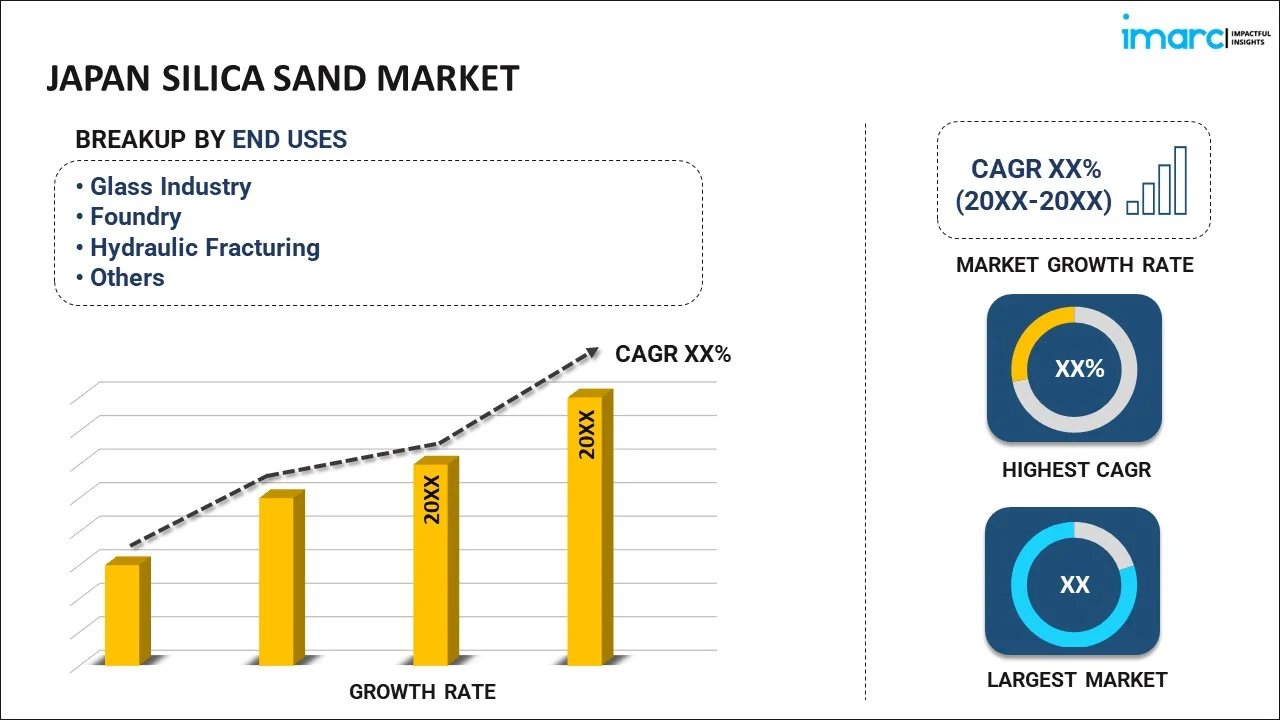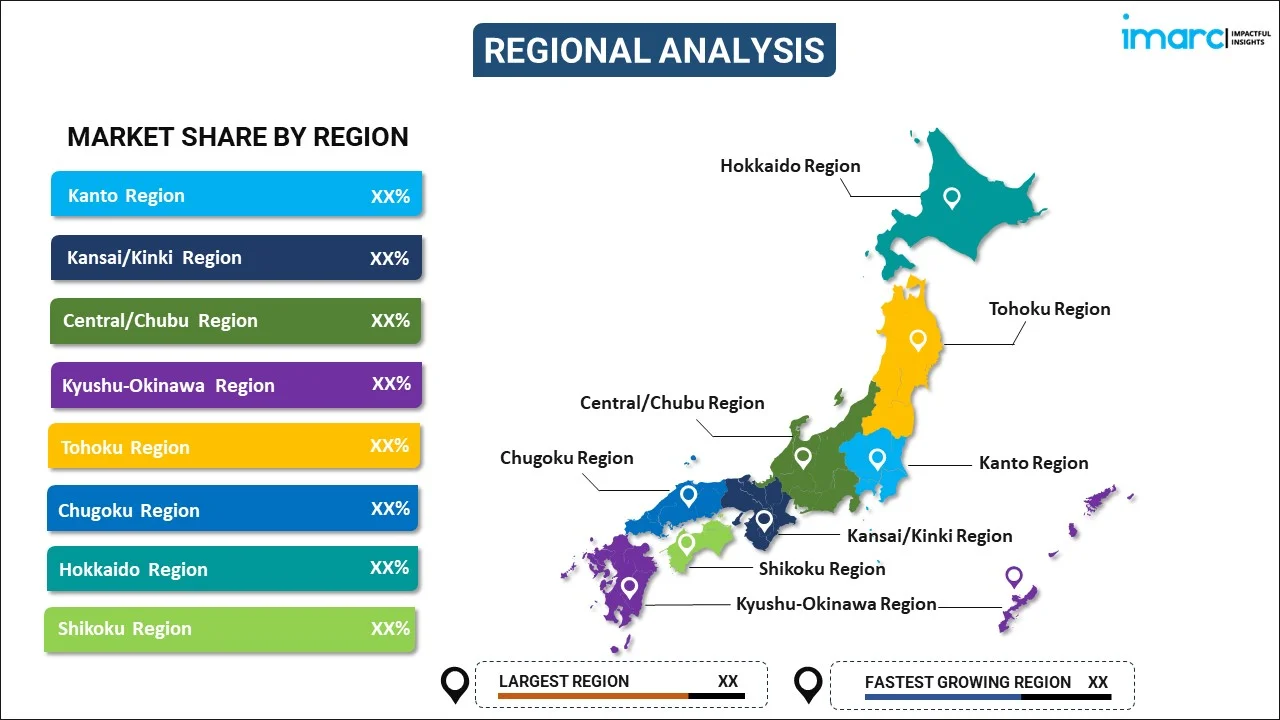
Japan Silica Sand Market Report by End Use (Glass Industry, Foundry, Hydraulic Fracturing, Filtration, Abrasives, and Others), and Region 2025-2033
Market Overview:
Japan silica sand market size reached 3.1 Million Tons in 2024. Looking forward, IMARC Group expects the market to reach 4.2 Million Tons by 2033, exhibiting a growth rate (CAGR) of 3.2% during 2025-2033. The increasing demand from the construction and manufacturing sectors, particularly in glass and electronics industries, infrastructure development, renewable energy initiatives, sports, and recreational projects, and ongoing research for innovative applications represent some of the key factors driving the market.
|
Report Attribute
|
Key Statistics
|
|---|---|
|
Base Year
|
2024 |
|
Forecast Years
|
2025-2033
|
|
Historical Years
|
2019-2024
|
| Market Size in 2024 | 3.1 Million Tons |
| Market Forecast in 2033 | 4.2 Million Tons |
| Market Growth Rate (2025-2033) | 3.2% |
Silica sand, composed primarily of quartz crystals, is a granular material derived from the erosion and weathering of rocks rich in silica. It is one of the most abundant and widely distributed minerals on Earth. Silica sand is characterized by its high silica content. It is natural resource that is available in various forms, including rounded grains, angular particles, or even sandstone. Due to its unique physical and chemical properties, silica sand finds extensive use in various industrial applications. It is a key component in the production of concrete and mortar, providing strength and stability to structures in the construction industry. Besides this, silica sand is crucial for manufacturing glass, as it melts at a high temperature and contributes to the transparency and durability of the final product. Additionally, silica sand is employed in the foundry industry for molding and casting metals, as well as in the production of silicon and silicon wafers essential for the electronics industry. Its versatility and abundance make silica sand a fundamental material in diverse industrial processes worldwide.
Japan Silica Sand Market Trends:
The growth of the Japan silica sand market is driven by the construction industry's robust demand for high-quality concrete and mortar. In confluence with this, the booming manufacturing sector, particularly the glass industry, heavily relies on silica sand for its unique properties that contribute to the transparency and structural integrity of glass products, which is strengthening the market growth. Moreover, the expanding product adoption as a molding and casting material across the foundry industry integral to manufacturing metal components is presenting lucrative opportunities for market expansion. Besides this, the electronics industry's reliance on silica sand in the production of silicon and silicon wafers, essential for semiconductors, in response to the burgeoning technological landscape, is contributing to the market growth. Concurrently, the flourishing expansion of Japan's infrastructure and urban development projects necessitates a consistent supply of silica sand for construction purposes, propelling the market forward. In line with this, the country's focus on renewable energy sources, particularly solar power, is spurring the demand for silica sand in the manufacturing of photovoltaic cells, creating a favorable outlook for the market expansion. Additionally, the emerging trend of sustainable and eco-friendly building practices underscores the importance of silica sand in green construction materials, providing an impetus to the market growth. Furthermore, the increasing popularity of sports and recreational activities, leading to the development of sports infrastructure and golf courses, is propelling the demand for silica sand in landscaping and construction. Apart from this, the rise in research and development (R&D) activities for innovative applications of silica sand, including its use in three-dimensional (3D) printing and nanotechnology, is positively impacting the market growth.
Japan Silica Sand Market Segmentation:
IMARC Group provides an analysis of the key trends in each segment of the market, along with forecasts at the country level for 2025-2033. Our report has categorized the market based on end use.
End Use Insights:

- Glass Industry
- Foundry
- Hydraulic Fracturing
- Filtration
- Abrasives
- Others
The report has provided a detailed breakup and analysis of the market based on the end use. This includes glass industry, foundry, hydraulic fracturing, filtration, abrasives, and others.
Regional Insights:

- Kanto Region
- Kansai/Kinki Region
- Central/ Chubu Region
- Kyushu-Okinawa Region
- Tohoku Region
- Chugoku Region
- Hokkaido Region
- Shikoku Region
The report has also provided a comprehensive analysis of all the major regional markets, which include Kanto Region, Kansai/Kinki Region, Central/ Chubu Region, Kyushu-Okinawa Region, Tohoku Region, Chugoku Region, Hokkaido Region, and Shikoku Region.
Competitive Landscape:
The market research report has also provided a comprehensive analysis of the competitive landscape. Competitive analysis such as market structure, key player positioning, top winning strategies, competitive dashboard, and company evaluation quadrant has been covered in the report. Also, detailed profiles of all major companies have been provided.
Japan Silica Sand Market Report Coverage:
| Report Features | Details |
|---|---|
| Base Year of the Analysis | 2024 |
| Historical Period | 2019-2024 |
| Forecast Period | 2025-2033 |
| Units | Million Tons |
| Scope of the Report | Exploration of Historical Trends and Market Outlook, Industry Catalysts and Challenges, Segment-Wise Historical and Future Market Assessment:
|
| End Uses Covered | Glass Industry, Foundry, Hydraulic Fracturing, Filtration, Abrasives, Others |
| Regions Covered | Kanto Region, Kansai/Kinki Region, Central/ Chubu Region, Kyushu-Okinawa Region, Tohoku Region, Chugoku Region, Hokkaido Region, Shikoku Region |
| Customization Scope | 10% Free Customization |
| Post-Sale Analyst Support | 10-12 Weeks |
| Delivery Format | PDF and Excel through Email (We can also provide the editable version of the report in PPT/Word format on special request) |
Key Questions Answered in This Report:
- How has the Japan silica sand market performed so far and how will it perform in the coming years?
- What has been the impact of COVID-19 on the Japan silica sand market?
- What is the breakup of the Japan silica sand market on the basis of end use?
- What are the various stages in the value chain of the Japan silica sand market?
- What are the key driving factors and challenges in the Japan silica sand?
- What is the structure of the Japan silica sand market and who are the key players?
- What is the degree of competition in the Japan silica sand market?
Key Benefits for Stakeholders:
- IMARC’s industry report offers a comprehensive quantitative analysis of various market segments, historical and current market trends, market forecasts, and dynamics of the Japan silica sand market from 2019-2033.
- The research report provides the latest information on the market drivers, challenges, and opportunities in the Japan silica sand market.
- Porter's five forces analysis assist stakeholders in assessing the impact of new entrants, competitive rivalry, supplier power, buyer power, and the threat of substitution. It helps stakeholders to analyze the level of competition within the Japan silica sand industry and its attractiveness.
- Competitive landscape allows stakeholders to understand their competitive environment and provides an insight into the current positions of key players in the market.
Need more help?
- Speak to our experienced analysts for insights on the current market scenarios.
- Include additional segments and countries to customize the report as per your requirement.
- Gain an unparalleled competitive advantage in your domain by understanding how to utilize the report and positively impacting your operations and revenue.
- For further assistance, please connect with our analysts.
 Inquire Before Buying
Inquire Before Buying
 Speak to an Analyst
Speak to an Analyst
 Request Brochure
Request Brochure
 Request Customization
Request Customization




.webp)




.webp)












